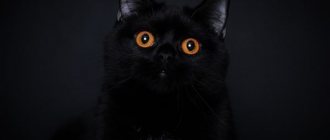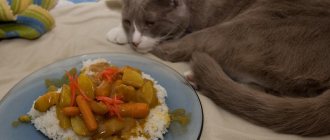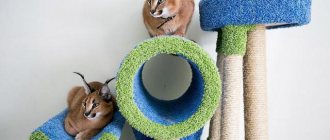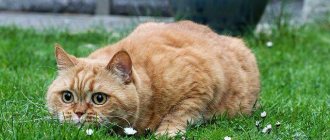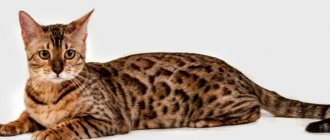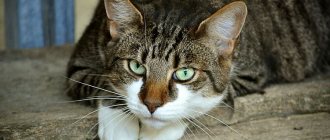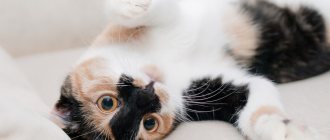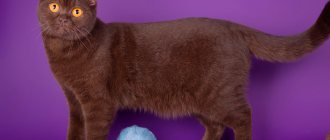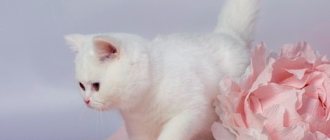Independent in nature, British Shorthair cats have strong bones, a rounded muzzle and large, expressive eyes. And their “plush” coat has become one of the many advantages of the breed. With proper care, the “British” can live 15 years or even more. But neither domestic cats nor those with access to free walks in the fresh air are 100% protected from diseases. Therefore, every owner should know what characteristics his pet has, and what should be taken as warning signs and signals for an unscheduled visit to the veterinarian.
- Diseases of the breed
- Symptoms
- Genetic diseases
- What are the most common diseases in British cats?
- Conjunctivitis
- Parasites
- Gastrointestinal diseases
Signs of a sick animal
At the initial stages, sometimes it is not possible to distinguish a healthy animal from a sick one. The reason is that the infection may not have yet spread throughout the body, so there are deviations, but they do not appear outwardly.
Over time, the symptoms of the disease become obvious. Of course, they will vary depending on the type of illness, but some nuances remain unchanged.
Among these:
- lethargy;
- refusal of stern;
- reluctance to play;
- low or high body temperature;
- dulling of fur;
- thirst;
- desire to be alone.
Important! If the animal behaves differently than usual, it has become restless or, on the contrary, passive, this is a reason to consult a doctor.
There are diseases whose progression is very rapid and whose symptoms are vague. Therefore, there is no need to wait until your pet becomes very ill.
Gastritis
Usually the occurrence of the disease is associated with an improper diet of the animal. For example, gastritis can be caused by a sudden change in diet, poor quality food, disruption of the regime, etc. Stress, worms and intoxication can also cause the disease. How can you tell if your cat has this disease? The disease manifests itself with the following symptoms:
- refusal of food;
- inactivity;
- severe vomiting;
- white coating on the tongue;
- problems with stool;
- unpleasant odor from the mouth.
Remember that repeated vomiting can cause dehydration. This condition is very dangerous for the animal. Therefore, you should go to the veterinarian as soon as possible so that he can prescribe the appropriate treatment.
Breed-specific diseases
The health of the British people, if not excellent, is very good. There are rarely problems with them, but all sorts of things still happen. There are not many ailments that affect these animals, but it will be useful for everyone to know about them.
Viral
Diseases of viral etiology are not uncommon in animals.
Most often it makes itself known:
- Panleukopenia . This disease is also called feline distemper. The disease is dangerous because it lowers the number of leukocytes and also affects the gastrointestinal tract. The disease can occur in pets of all ages; it responds well to treatment, but you should not let the disease progress, because it can cost the purr’s life.
- Leukemia . This is oncology. The disease affects the furry circulatory system. Unlike people, the disease does not occur on its own in animals; you can become infected from sick animals, as well as through food. Considering that the disease passes in a latent form, the pathology does not manifest itself for a long time. Unfortunately, the disease cannot be cured, but by choosing the right treatment tactics, it will be possible to extend the Briton’s life by 5-7 years.
Endocrine system disorders
When talking about endocrine diseases, only diabetes mellitus comes to mind. This is an ailment that does not allow the cells of the body to be fully nourished. It is not difficult to notice the problem, because the animal begins to quickly gain weight or, on the contrary, lose it.
In addition, you can pay attention to symptoms such as:
- smell of acetone from the mouth;
- thirst;
- weakness;
- oppression.
Timely treatment will make it possible to restore the pet’s condition.
Gastrointestinal tract
Diseases affect British cats extremely rarely. However, if they are diagnosed, then most often the problem lies in the gastrointestinal tract.
Animals encounter:
- Feline constipation. Trouble makes itself felt at any age. A caring owner will not miss the moment when the pet begins to sit on the potty for a long time and push hard, trying to poop. There can be a great variety of causes for the disease; only a doctor can determine the exact cause. In addition to problems with defecation, you can notice depression of the fluffy, refusal to feed, and apathy.
- Colitis. We are talking about inflammation in the large intestine. It is in this part that fluid is absorbed and feces are formed. If inflammation occurs in the intestine, then motility is impaired, therefore, stool changes its structure, and in addition, blood or mucus may be observed in it.
- Coronavirus enteritis. This disease is contagious and infectious in nature. The problem arises due to inflammatory processes occurring in the large intestine. In a mild form, the disease responds well to treatment, which cannot be said about a severe one. However, it is much easier to notice the second one - the animal’s digestion process is disrupted, and there are also signs of a cold.
- Gastritis. Many people believe that gastritis is not a pathology at all, but a temporary disorder, but this is not so. Of course, this is not a common disease in British cats, but if you don’t pay attention to it, it will lead to serious consequences. Experiencing unpleasant sensations, the pet will refuse food, and it may begin to vomit undigested food debris. This will lead to poor digestibility of food, as well as general poor health of the animal. In this case, feeding the British plays an important role, which should be balanced, but at the same time nutritious.
Leukemia
This is a cancerous disease. The disease affects the circulatory system. A cat can become infected from a sick cat. The disease develops asymptomatically over a fairly long period of time. Gradually, the animal's appetite decreases and it becomes inactive. The disease is practically incurable. Expensive foreign drugs are used as therapy.
General diseases
By properly caring for cats, you can eliminate a number of diseases that may make themselves known. Although there are those that are able to appear regardless of the living conditions of the animal.
Respiratory diseases
Respiratory ailments include a group of infectious diseases that include mycoplasmosis, chlamydia, calicivirus infection and rhinotracheitis. The difficulty lies in the fact that an animal can simultaneously have several pathologies, the symptoms of which are very similar.
It is impossible not to notice a cat's sneezing, nasal discharge, tearing, and wheezing. In the initial stages, the pet does not lose its activity, but later it begins to worry and may stop eating and breathe heavily. British kittens are much more susceptible to infection because they have not yet developed a fairly good immune system.
Worms
Such a problem as worms sometimes makes itself felt in very unusual ways. The animal may develop chronic diarrhea or cough. This disease is special in that, in fact, it is not a disease, although it causes a lot of harm and can even cause the death of a cat.
The most common worms are:
- flukes;
- tapeworms;
- roundworms.
Worms are very dangerous because, having settled in the animal’s body, they begin to suck out all the beneficial juices from it. The owner of a furry pet should know that worms feed on the tissues of various internal organs, lymph and blood. The pet can “melt” before our eyes, and people will not understand what is happening to it. Of course, British kittens are not vaccinated against parasites, but babies can be protected from helminthic infestations by using antihelminthics, which can be started at two months.
Diseases of teeth and claws
Proper nutrition for cats and caring for the animals’ oral cavity will make it possible to avoid the development of diseases such as tartar, caries, periodontitis, osteomyelitis, and gingivitis. It is not difficult to notice these problems if you look into your pet’s mouth. Just like in humans, cats may have plaque, bleeding, and loose teeth on their teeth. If it has been noticed that your pet refuses food or chews only on one side, then this is a reason to sanitize the oral cavity.
In addition to teeth, dermatophytes and other types of fungal infections sometimes occur. Often the problem appears on one or two claws, but in some cases the problem can be observed on all the others. The claw is dark or constantly peeling.
Eye diseases
Eye problems in the British are rare. They usually appear due to injuries or drafts. The most common disease is conjunctivitis. The pet's eyelids suddenly begin to redden and swell, and the eyes constantly water and tears flow.
Keratitis is a disease that rarely makes itself felt, but it should also be talked about. If an animal constantly produces large quantities of tears from one eye, then you can try to suspect this particular disease.
Blepharitis, or inflammation of the eyelid, can be meibomian, ulcerative, or scaly. During an animal's illness, an inflamed eyelid appears to fall on the eye, which is very disturbing.
The problem is that this disease can develop into panophthalmitis. Neglect of the pathology often leads to loss of the eye.
In cases where darkening of the lens was noticeable, cataracts may be suspected. Over time, this symptom is accompanied by deterioration of vision, the animal walks very slowly and relies more on its sense of smell.
If the mustache has a dilated pupil, and hemorrhage can be seen on it, then most likely we are talking about glaucoma. This problem causes a lot of inconvenience for the animal, so you need to rush to the doctor.
Important! Having noticed that something wrong is happening to an animal, you should not try to diagnose it yourself or start treating it, this can “wash away” the symptoms and delay treatment.
Eye problems
What eye diseases is the British cat susceptible to? For example, conjunctivitis. What kind of disease is this? This is an inflammation of the mucous membrane of the eye. Representatives of the British breed have a special head structure. For this reason, their eyes are very vulnerable. Conjunctivitis indicates an infectious lesion. It is important to find out the reason for its appearance. The disease can occur in a British cat due to mechanical damage, allergies, or a viral disease. Regardless of the nature of the disease, you need to undergo a course of treatment. Drops and ointments are usually used topically.
Another disease of British fold cats is epiphora. The disease manifests itself as abundant discharge from the mucous membrane of the organs of vision. This disease is very common among representatives of the breed. The disease is associated with many reasons: blockage of the tear duct, inflammation of the eyelids, volvulus, unnatural structure of the tear duct, etc. Antimicrobial drugs are used for treatment.
Genetic disorders
Scots and Britons are most likely to experience haemophilia and cardiomyopathy. In the first case, we are talking about poor blood clotting and increased bleeding time. Even a minor cut can cause a lot of blood loss.
As for the second disease, it is divided into:
- Hypertrophic cardiomyopathy. This type of disease, during which the walls of the heart enlarge, is more common than all others.
- Dilated cardiomyopathy. With this type, the thickness of the walls does not change, but the volume of the heart increases.
- Restrictive cardiomyopathy. During the problem, fibrosis of the heart develops - the hard muscle cannot contract as before, which leads to serious consequences.
Symptoms
If you notice any other symptoms listed above, immediately contact your nearest veterinary clinic.
Refusal to eat is the first sign that something is wrong with your cat. The presence of a more serious disease may be indicated by vomiting or diarrhea . Some owners are mistaken in thinking that if you touch a cat’s nose and it turns out to be cold, then the animal is quite healthy. This is absolutely not true. Temperature should be measured with a thermometer specifically designed for animals.
A normal temperature is considered to be between thirty-eight and thirty-nine degrees; if the reading is higher, then your pet is seriously ill, and care not provided in time can lead to serious consequences.
An increase in body temperature may mean that a British Shorthair has serious diseases such as pneumonia or a disorder of the central nervous system.
Kitten diseases
Some people believe that pneumonia is something that babies often experience, but this is not entirely true. These little furbabies can be affected by the same diseases as adults. In this case, the signs of the disease in kittens of British cats will be similar to those of their parents. The only difference is that it is more difficult for children to resist diseases. To prevent this from happening, you should carefully monitor your pets. And timely prevention and vaccination will help protect your pets from many diseases.
Did you like the article?
Helminthiasis
This disease is caused by the presence of tape and round parasites in the cat’s body. The symptoms of the disease are as follows:
- discharge from the eyes;
- digestive problems (diarrhea, constipation, etc.);
- rapid fatigue;
- deterioration of coat condition;
- apathy;
- unsteady gait;
- rapid fatigue.
To prevent damage, it is necessary to regularly carry out scheduled deworming once a quarter. A disease such as helminthiasis is contagious to people. If a cat has worms, then prevention should be carried out on all family members.
Panleukopenia
This terrible disease is caused by a virus; pancleicopenia is a fatal disease; cats of any breed are susceptible to it. The virus affects the stomach, heart and respiratory organs, and the level of leukocytes in the blood drops significantly. Then dehydration begins, coordination is impaired, breathing and heart rate increase. At the final stage, the death of the animal occurs. Only preliminary vaccination can save your pet from this disease.
Therapeutic techniques
If any of the above symptoms appear, you should immediately take your pet to a veterinarian. A sick cat should be given complete rest, especially carefully isolated from small children. There is no need to play or tease the cat, as any sudden movement is fraught with sudden paralysis. At first, if the symptoms are not too threatening, drug treatment is practiced, the purpose of which is to stop the inflammatory process. But in most cases, this only manages to smooth out the main signs. There is no talk of a complete cure without surgery.
It is highly advisable to prescribe sedatives to a sick pet, which will naturally limit the animal’s activity and eliminate the possibility of sudden movements. Drug pain suppression is recommended only for cats that feel pain and retain tactile sensation. In other cases, it is not recommended to prescribe painkillers, as they can blur the picture of the course of the disease.
In veterinary practice, there have been many cases where cats, after four to six weeks of complete rest, treated with non-steroidal anti-inflammatory drugs, fully recovered. However, there are also many relapses, especially in the case of animals that have already reached the age of five or seven years.
If no significant improvements are observed throughout the course of drug treatment, or if there is a marked tendency towards worsening the course of the disease, surgery is strongly recommended. The sooner this is done, the greater the chance of a complete recovery of the animal.
What is the essence of surgical intervention for this pathology? In most cases, what is called “surgical decompression” is used. This is a method in which the “prolapsed” part of the spinal disc is partially excised, restoring the outer lining of the organ. Decompression is the only effective treatment when paralysis or para/tetraplegia occurs.
Complex uroliths
Consist of a core formed by one type of mineral and a stone or shell formed by another type of mineral. They are formed in cases where factors first act to promote the crystallization of one mineral, and then conditions arise under which crystallization of another mineral occurs. Some types of minerals may also function as a core upon which further deposition of other inorganic substances occurs. All types of uroliths contribute to the development of urinary tract infections, which, in turn, accelerate the precipitation of struvite.
Complex urolith. The core consists of acid ammonium urate, the shell is made of struvite
The dietary therapy strategy is to eliminate factors that contribute to the formation of complex urinary stone nuclei. It is recommended to give sick cats wet food or add water and sodium to it: this helps reduce the saturation of urine with components from which uroliths are formed.
British cat pregnancy
Don't think that when you take your cat home after breeding, you will immediately notice that she is pregnant. The British woman will continue to flow for the entire time allotted by nature, and the first signs of pregnancy may appear only after 2-3 weeks. First of all, your pet's nipples will increase in size and take on a bright pink hue. The cat will also begin to sleep a lot, eat less, and demand affection from the owner.
On average, British cats stay pregnant for 68 days. Pregnancies that last less than 60 days most often result in obstructed labor, which results in the death of the kittens. You can determine the exact gestational age and the time when your pet is due to give birth by drawing up a special calendar, taking into account that conception occurs 25-48 hours after coverage.
When cats of the British breed carry kittens already at 9 weeks, they independently arrange a “nest” for childbirth and try not to lose sight of the owner.
During this period, a happy owner must properly care for the British cat: limit physical activity, ensure proper nutrition (especially if the cat sheds heavily) and show your care and attention!
How long do they live?
Cats often live longer than dogs; while many of the latter have only ten years left, the former have an average lifespan of fifteen years, and even longer in good home conditions. This is due to their small size and adaptability.
They can fall from a height and stand up on their paws, for example, and are generally very tenacious. Among these four-legged animals, the Siamese are considered to be the record holders for the longest lifespan, while the British live on average twelve to fifteen years. If certain factors exist, this period may be extended.
Large breeds live shorter lives, but if your pet has long-lived relatives, he most likely has great potential. With proper care, it can cross the average threshold and quietly delight you for eighteen and sometimes twenty years.
Obese animals have less chance of this and are susceptible to heart, liver and stomach diseases. If they move little, their muscles are not toned, their metabolism slows down, which greatly affects their health.
How can you tell if your pet is sick?
Cats can't talk, they won't be able to tell you what's bothering them. Owners should be aware of symptoms such as:
• The pet begins to refuse food, and less often, to drink; • Eyes turn red; • Hair falls out; • Body temperature may increase; • Difficulty breathing; • Frequent urination, loose stools, etc.
The most characteristic pathology for the British is the presence of two blood groups (A and B). Of course, this feature is not a full-fledged disease. Troubles arise only when breeding offspring. Kittens that have two blood types at birth very often die within the first 3 days of life. Death occurs because when interacting with the milk of the mother cat, the cells begin to collapse.
Scientists have developed a special DNA test for cats, which allows identifying pathology of blood types at an early age.
Appearance and standard of the British
The modern British cat, whose price is usually quite high, is a large or medium-sized animal with a harmonious build. It is distinguished by a round muzzle with well-developed cheeks and wide cheekbones, a thick neck, small, wide-set ears and large, wide-set eyes. Eye color is bright orange, blue or emerald green.
Different types of British cats are distinguished by color:
- Plain (black, chocolate, blue-gray, purple, white body).
- Color point (light body and blue eyes). As a rule, it darkens with age.
- Tortoiseshell (red-black or cream-blue individuals). Uniform compatibility is more preferable, however, fewer requirements are imposed on such colors than on solid colors.
- Smoky (cameo, chinchillas, smokes). Contrasting color: black tips and snow-white undercoat. In this case, the head, back, legs are darker than the sides and ears. Eyes orange or white.
- Tabby (stripe, spot, marble). The color and pattern are very different; the letter “M” is clearly visible on the forehead. The rings on the neck and chest are not interrupted, there is a clear line from the corner of the eyes, the entire perimeter of the back is also covered with a pattern resembling a butterfly.
This takes into account not only the actual color and pattern of the coat, but also the undercoat, eyes, paw pads, and nose. There are 62 species in total. Moreover, both the British marbled cat and, for example, the British lilac cat, are equal and full representatives of their breed. One of the favorites is the British blue cat, the description of which breed is most often searched for.
Special attention is paid to the tails of exhibition animals. According to the standard, the British cat breed must have a thick “pole” with a rounded tip. A thin or tapering tail is a clear defect in the individual. The average weight of a healthy adult pet is 3-7 kg. Read about the beautiful plush cat - the British chinchilla.
